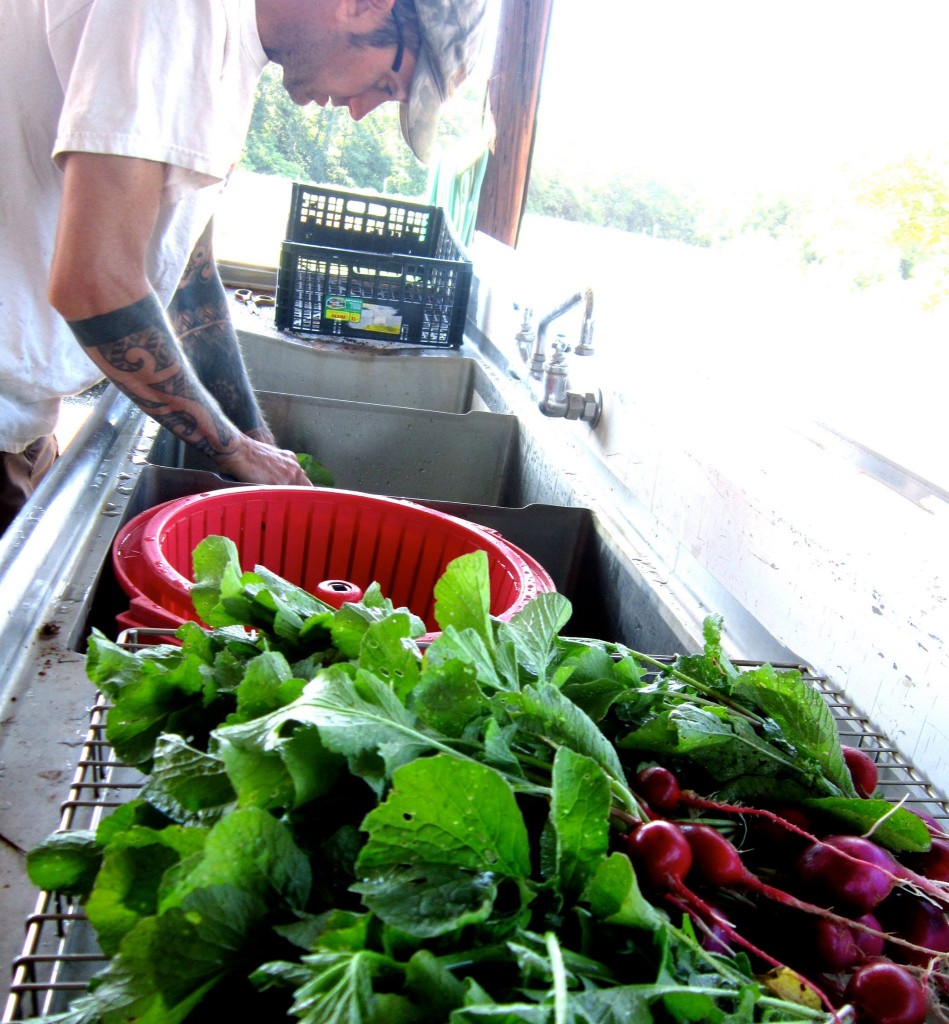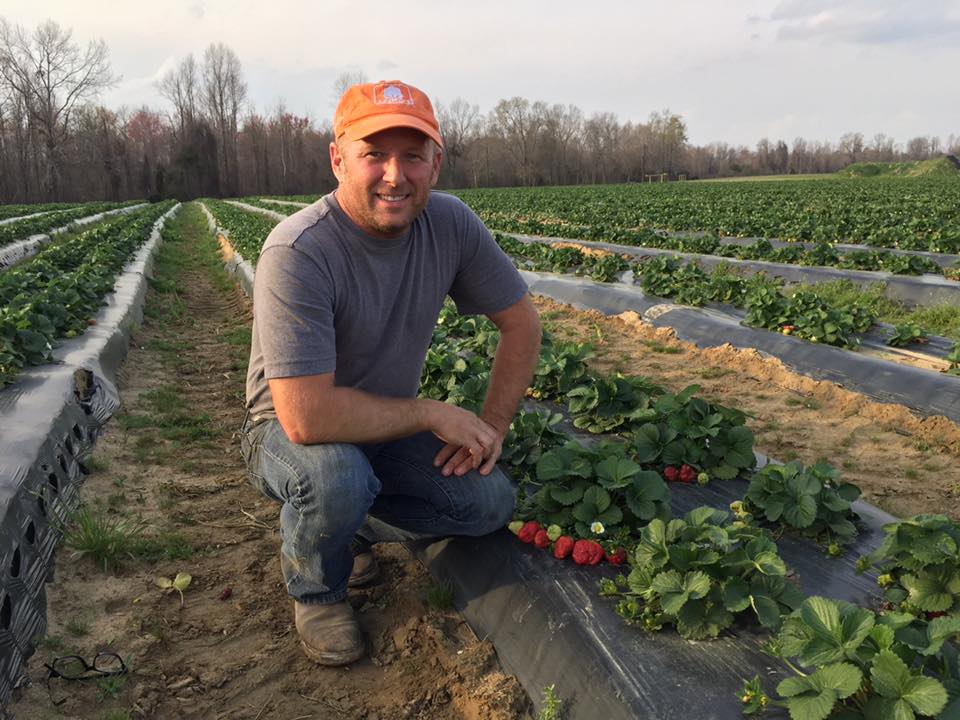by Patricia Tripp, CFSA’s Local Produce Safety Manager

Dylan Alexander of Alexander Acres, one of the Farmers in Training at Lomax Incubator Farm, washes produce post-harvest.
Growers can produce large quantities of fruits and vegetables all day long, but without the proper systems in place you could miss out on the critical window of time when your produce is fresh and high-quality enough for market. Miss the window and product losses could be extensive. Taking every measure to improve product quality through the implementation of a food safety program will help to open up new market opportunities, reduce losses and improve the overall viability of your business.
Many do not want to hear about food safety, but the fact is that food safety is the number one topic relating to fresh produce today. So for those of you who have not jumped on the food safety train, it is highly recommended that you familiarize yourself with the requirements of Good Agricultural Practices (GAP) and Good Handling Practices (GHP) and slowly implement what you can on the farm, with a focus on product quality. Good Handling Practices (GHP) are different from Good Agricultural Practices (GAP), only because GHP is the term used postharvest, versus while crops are still in the ground or being field packed (GAP).
CFSA’s one-on-one GAP consulting services are provided on a first-come-first-serve basis to CFSA members for free.
Controlling Surface Microorganisms on Fresh Fruits and Vegetables
Simple techniques for controlling microorganisms living in the natural environment, including bacteria, yeast and molds, can maximize the shelf-life of your product. Bacteria, especially, can become internalized in fruits and vegetables and can lead to rapid degradation of your products. For example, insects and birds are a source of microorganisms, and all crops have the potential of becoming unhygienic by either source. Insects can cause injury, and even birds, to some crops by damaging the protective cuticle of the leaves or by damaging the fruit or vegetable itself. This provides an entry point for microorganisms, either reducing the yields of the plant through decreased immunity or reducing the shelf-life or marketability of a product because of quality.
Most growers already have an integrated pest management (IPM) program in place to rid crops of potential pests. Implementing a wildlife deterrent and monitoring program to help prevent birds, deer and other wildlife from entering your crop production areas is required by GAP and will reduce the potential risk of microorganism contamination. Try reusing some of your music CD’s to create wildlife deterrents. Simply hang them from a tree or fence post with fishing line, allowing them to move freely with the wind. Wildlife will be startled by the reflection created by the sun.
Minimizing Water Contact Unless Necessary
Consumers are very accustomed to washed fruits and vegetables today, but do they know that the soil remaining on the surface of the produce actually extends the shelf-life of the product? Taking this into consideration, along with the fact that water is the number one source of microbial contamination, growers throughout the Carolinas have recently learned that it may not be necessary to wash every piece of produce that is grown. As a matter of fact, several Chef’s have recently commented that they have requested that growers not wash the produce being delivered to their restaurants in order to extend the shelf-life of the product, especially root crops, tomatoes and squash. If every customer would accept produce straight out of the field, assuming extra soil is brushed off, this would help achieve a longer shelf-life as well as cut costs for the growers. However, we are a long way from convincing buyers that this is an acceptable practice. In the meantime, growers must minimize food safety risks, ensuring that water quality in the washtub or dump tank does not become a source of microbial contamination.
Many vegetables, such as tomatoes and even summer squash that has been injured with a stem, are at high risk of infiltration of the water when submersing products for washing. Wash water that is recirculated becomes contaminated when dirt and debris settle in the bottom of the washtub creating the potential for microbial contamination. Infiltration of water causes rapid decay of the fruit or vegetable internally. There are many factors that should be taken into consideration with washing produce such as water temperature, the use of a sanitizer, ensuring potability of water and reduction of microbial load and the pH of the water. These requirements are very crop specific, so seek out expert advice from CFSA staff or your local extension agent to ensure that you are implementing procedures that will improve product quality.
A Success Story – Local Produce Safety Initiative

Jay Willard of Willard Farms, Gable, SC recently utilized CFSA’s GAP Consulting services and achieved GAP certification Photo courtesy Willard Farms
CFSA recently worked with Willard Farms in South Carolina who attended a GAP workshop on February 16, 2017. Jay Willard stated that becoming GAP certified had been a one-and-a-half year process, primarily due to the fact that Jay did not know where to start and lacked necessary resources. Willard Farms was officially GAP certified on March 10, 2017, less than one month after attending the GAP workshop and taking advantage of CFSA’s LPSI consulting services.
Although it is not recommended that you accomplish GAP certification on such a short turn around, Jay had the advantage of attending multiple workshops over the years and so had a solid understanding of the requirements of the Harmonized GAP Audit. This level of knowledge allowed Jay to move forward very quickly in the process, including writing his Food Safety Plan.
Knowing every farm in America will need to comply with at least minimal food safety requirements, it is never too late to start learning about the process and having a goal set to implement a food safety program on your farm. Implementing a Food Safety Program on your farm will assist you in overcoming barriers of entering into new markets and improving the quality of your product. You’ll also be able to supply verification that your farm follows Good Agricultural Practices and Good Handling Practices if you choose to undergo an audit.
Learn more about CFSA’s Local Produce Safety Initiative’s one-on-one consulting services or email Patricia Tripp.


